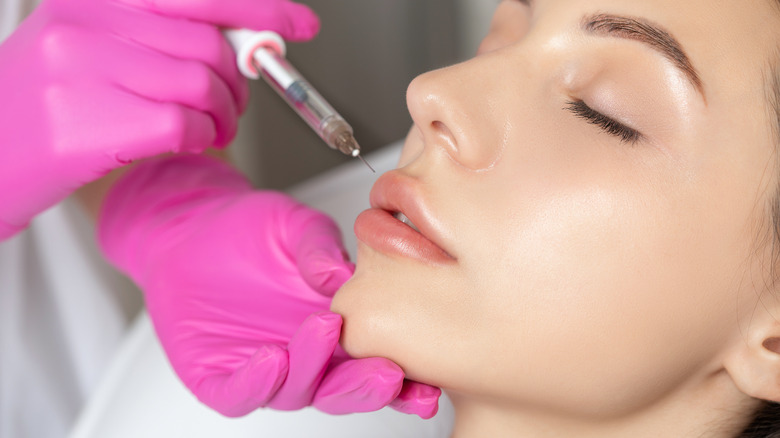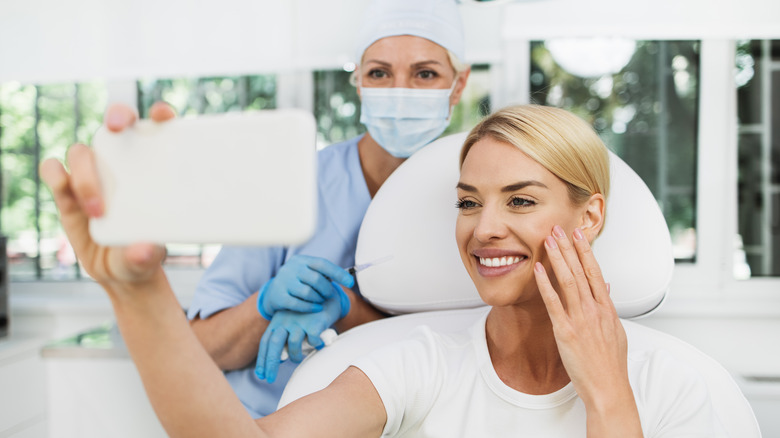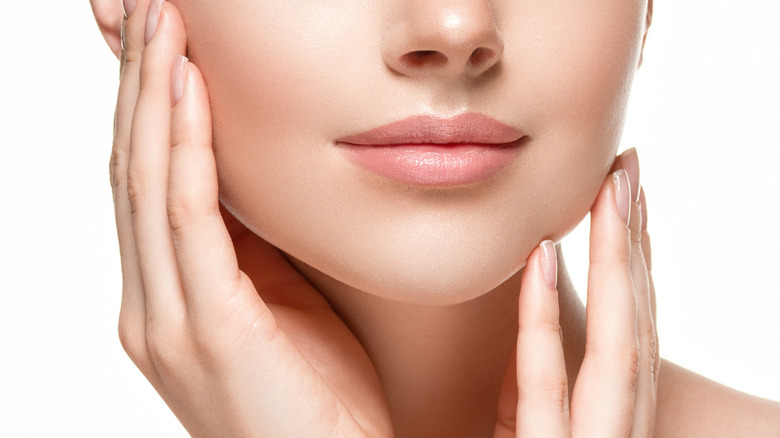What Is A Lip Flip Procedure?
Lip fillers are all the rage nowadays, but there's an even better way to get fuller lips and still maintain a natural appearance. We're talking about the Botox lip flip, a minimally invasive cosmetic procedure with subtle results. The American Board of Facial Cosmetic Surgery (ABFCS) explains that lip flips can temporarily correct a gummy smile and help you achieve a pouty look. Plus, it has a lower price tag than lip fillers and requires no downtime.
In 2020, soft tissue fillers — including lip fillers — were the second most popular nonsurgical cosmetic procedures in the U.S., reported the American Society of Plastic Surgeons. This trend is largely driven by social media, but it also has a cultural component. "Much like how studies show that the higher your hip-to-waist ratio in some African tribal cultures, the more attractive you are, full lips can also make you seem more attractive," anthropologist Jamie Gordon told Women's Health. Plus, fuller lips are also associated with youth and sexuality.
Regardless of your reason for wanting plump lips, it's important to choose a procedure that suits your needs. The Botox lip flip provides more natural results than lip fillers, but it's not for everyone. Some patients have difficulty eating, speaking, or drinking through a straw following the procedure, explains the ABFCS. Others find the results too subtle and feel like they wasted their money. With that in mind, make sure you understand what the lip flip procedure entails and how it differs from lip fillers.
What you should know before getting a lip flip
The lip flip is a nonsurgical cosmetic procedure designed to enhance the upper lip and Cupid's bow. Most patients require 4 to 6 Botox units, which are injected near the middle of the top lip and the corners of the month, says the American Board of Facial Cosmetic Surgery. Surgeons may use up to 8 Botox units to improve a gummy smile. The results are usually visible within a week or so and can last for three to four months.
Unlike lip fillers, this procedure doesn't increase lip volume. Instead, it improves the contour and shape of the upper lip, giving the illusion of fullness, explains a recent review published in the Journal of Craniofacial Surgery. Another difference is that lip fillers contain hyaluronic acid, calcium hydroxylapatite, or other dermal fillers, whereas the lip flip procedure uses Botulinum toxin type A. This compound relaxes the muscles around your lips, making them look plumper.
Some patients choose to get both procedures, as the lip flip can enhance the results achieved with lip fillers, notes the ABFCS. Lip flips can also improve the appearance of your mouth by reducing wrinkles and fine lines. Both treatments are non-invasive and cause little or no pain. Lip fillers provide longer-lasting results, but you might end up with an overdone look (think: duck lips). Luckily, that's not the case with the lip flip.
Is the Botox lip flip worth it?
This minimally invasive procedure may or may not be right for you, depending on the desired outcome. A lip flip can enhance your smile and give you a more youthful look, but it won't transform your appearance. Isabella Wight, a regular contributor to Fashion Journal, says that her upper lip was "slightly fuller, less gummy, and still very natural-looking" following the procedure. As far as price goes, you can expect to pay up to $100 for a Botox lip flip, which is significantly lower than the cost of lip fillers, according to the ABFCS.
The lip flip can be a good choice for those with a gummy smile, suggests a 2016 study featured in the Dental Research Journal. As discussed earlier, this cosmetic procedure will make your top lip look fuller and more defined. Therefore, it can reduce gingival exposure when you speak or smile, leading to greater self-confidence. Plus, it doesn't carry the risks associated with a gingivectomy or jaw surgery, note the study authors. You may also want to consider this treatment if you have a thin upper lip or fine lines around the mouth.
Last but not least, take into account the risks involved. A lip flip may not be suitable for teachers, lecturers, singers, and other professionals because it can temporarily affect their ability to speak, warns the ABFCS. There's also a risk of localized bruising, numbness, headaches, nausea, and mild swelling, but these side effects usually subside within a day or two.


